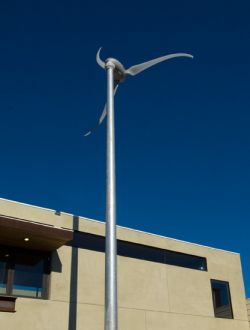I never really thought much about small wind’s potential as a significant source of a city’s electricity supply. Windmills in a urban setting? I just don’t see it.
 Didn’t see it, that is, until I saw it. The other day I biked by 1303 Alabama St., in the Mission District of San Francisco. Softly — very softly — whirring overhead is a 1.9 kW Southwest Windpower Skystream windmill. The Choose Renewables resource estimator says that it’s a class 3 wind site, but I wouldn’t be surprised if it’s actually higher. As any San Franciscan knows, the Mission can be very sunny and pleasant during a summer day, but on summer evenings, as the marine layer moves in, the wind just nukes over Twin Peaks and the South Mission/Noë area can be a wind tunnel.
Didn’t see it, that is, until I saw it. The other day I biked by 1303 Alabama St., in the Mission District of San Francisco. Softly — very softly — whirring overhead is a 1.9 kW Southwest Windpower Skystream windmill. The Choose Renewables resource estimator says that it’s a class 3 wind site, but I wouldn’t be surprised if it’s actually higher. As any San Franciscan knows, the Mission can be very sunny and pleasant during a summer day, but on summer evenings, as the marine layer moves in, the wind just nukes over Twin Peaks and the South Mission/Noë area can be a wind tunnel.
The result, I expect, makes for propitious economics. The house also has a 5 kW SunPower solar system. California’s system peak is shifting later and later, which is being reflected in PG&E’s tariffs. The old E-7 Residential Time of Use (which is being phased out) had a summer peak of 12 to 6 p.m. The new E-6 has a summer peak of 1 to 7 p.m., and a partial peak of 7 to 9 p.m. In practice, that means that as the solar system’s production winds down in the early evening, the windmill steps in and produces electricity that would have cost up to 53 cents/kWh if bought from the utility.
That’s just a wonky way of saying that wind and solar are like peanut butter and chocolate: great on their own, but even better together.


